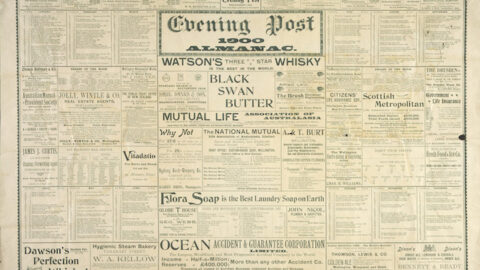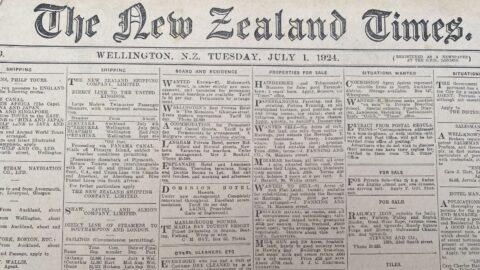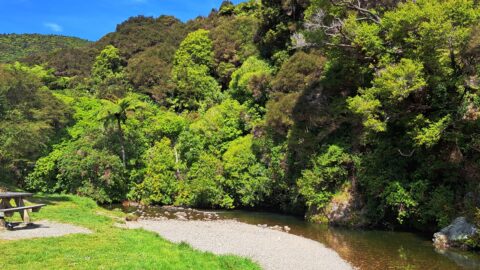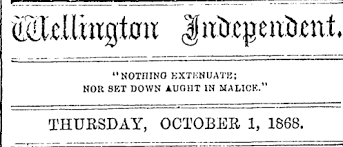WELLINGTON WATER-SUPPLY.
OFFICIAL INSPECTION OF THE WAINUI WORKS.
(BY OUR SPECIAL REPORTER. Saturday, February 26.)
As a result of the disquieting information contained in the City Engineer’s report presented to the City Council on Thursday last, an official inspection of the Wainui-o-mata Waterworks was made on Saturday last by his Worship the Mayor and Councillors Benzoni, Coombe, Banks, and McKenzie, accompanied by the City Engineer (Mr Loughrey), and a representative of the New Zealand Times.
The party left town about half-past 9 in two waggonettes, and arrived at the works shortly after noon. On arriving at the well, a concrete basin some 60ft deep, into which the water from the race empties itself previous to passing through the iron mains (30in in diameter) into town, the road begins to run along the side of a somewhat precipitous hill, well clothed with vegetation, immediately to the left being the water-race a mile and a quarter in length, and on the right, at a depth of 30ft or 40ft, the remains of the Wainui-o-mata River, after its flow has been intercepted at the dam above.
The water in this stream indicates the amount of waste by leakage from the dam and overflow, aided by the leakage in the race above referred to. The amount of water in the stream on Saturday was by no means large, but in all probability, if accurately measured, it would represent the difference between scarcity and abundance to the city supply.
Ascending the hill from the well, the leakages from the race manifested themselves by running streams on either side of the road, cutting channels varying in breadth from two or three inches to nearly a foot, through which, in some places, the water rippled with sufficient force to indicate a considerable loss during the 24 hours.
On arrival the party, accompanied by Mr Quaintance, the caretaker, proceeded to inspect the leaks which had been stopped since the Engineer’s visit on Wednesday last. Here, however, it may be judicious, in order that the reader may better understand the undertaking and its apparent defects, to convey an idea of the waterworks.
Briefly, then, the Wainui River, which is fed by a large watershed composed of numerous hills, is intercepted by a concrete breastwork in a curve of a hill which forms almost a natural basin. Before encountering the breastwork, or dam, as it is called, the water passes over a natural shingle bed, and is considerably purified in consequence.
The dam is perforated by two tunnels, one conveying the water through the race to town, and the other forming an outlet to the old riverbed, in order that the water in the reservoir may be drawn off, should occasion require it, for the purpose of cleansing or repairing it.
Both tunnels are opened or shut by ordinary hydraulic screw valves. In addition to these tunnels there is a by-wash over which the surplus water flows into the old river bed when the reservoir is full, which is commonly the case except in dry seasons.
Indeed, it is said that the amount of water which passes over this by-wash, and is consequently lost, would, if stored, suffice for the wants of a city very much larger than Wellington. However, the by-wash is in no way responsible for the present deficiency of the supply, for on Saturday the water was 61 inches below the top of the wall, and the river-bed beyond was perfectly dry.
The outflow tunnel, or sludge channel, however, indicated a great loss of water, caused evidently by the faulty flood-gate or valve, for a sheet of water 9 feet wide and over an inch in depth flowed out of the sluice at the rate of 9 feet a second into the old river bed.
The race which conveys the water to the well above referred to is built of concrete, and runs for a distance of 96 chains, its interior invert being 3ft wide by 4ft high. From the well, 60ft deep, which rises and falls in sympathy with the town consumption, the water is conveyed by 30in mains to the city.
It is the well that gives the pressure, and any sudden demand in town immediately affects it and causes a strain on the mains, many of which cannot stand the irregular pressures and burst in consequence. To give an equal pressure this well must be kept constantly full, which cannot of course be the case when the supply from the race, from whatever cause, is reduced.
The overflow from the well finds its way to the old river bed of the Wainui-o-mata River, and is consequently wasted.
But to return to the inspection of the race—proceeding downhill, accompanied by the caretaker—the lesser of the two serious leaks referred to by the City Engineer was temporarily repaired from the outside by puddling, but on a boulder or two being removed and a quantity of mud scraped away, the water began to flow rapidly, thus indicating that a crack of some magnitude had taken place in the cement.
Continuing a little farther down the road we reached the spot where, for a distance of 25ft, the water had been pouring undetected for some time through a crack varying in breadth—as it is alleged—from ½in to 3in. No water was coming through this on Saturday, however, as the caretaker had, by instructions of the Engineer on Wednesday last, stopped the leak by means of old sacks, clay, etc.
It would be difficult to say how long this particular leak had been in existence, as the water had made its way under the road into the old river-bed, and was not visible, therefore, like the smaller leaks whose waters pass over the road.
It was apparent that the leak had been caused by a subsidence of the race, under which the outflow of a gully in the hill above finds its way to the riverbed. A concrete wall had been built at the base of the gully by the contractor, but was apparently inefficient for the purpose.
The exterior of the race having been surveyed, it was resolved to turn the water off and make an interior inspection after lunch, but before returning, Councillor Coombe measured the depth of water in the race, and found it to be 8⅓in.
On arriving at the dam, the water was cut off from the race, and a light lunch (kindly supplied by the Mayor) was partaken of in Mr Quaintance’s house. After this necessary delay, a walk was taken to the river proper, about 40 chains from the house, where the flow into the dam was gauged and found by the Engineer to be about three millions and a quarter gallons per 24 hours.
As the flow is estimated sometimes at over ten million gallons, some idea may be gathered of the effect upon the river of the recent dry season.
Returning to the race, the Mayor, the City Engineer, and your “special correspondent” descended a man-hole leading to the race, and proceeded on hands and knees to explore a section of the interior, each person carrying a candle as best he could.
Councillor Benzoni also essayed a considerable portion of the journey, whilst Councillor McKenzie very pluckily went below despite his portly form, but wisely returned.
Although the water had been turned off there was a flow of from three to six inches along the bottom, which made the journey difficult and disagreeable, while the amount of wriggling required to sustain locomotion was exhausting, not to say painful.
Stalactites a foot long were depending from the roof, and numerous small fish were encountered, one being as big as a herring.
A very short distance sufficed to show that the race is in anything but a good condition. The “rendering” or coating of cement above the floor has peeled off, and is still peeling off in large flakes in places all along the sections inspected, while there are numerous holes in the concrete large enough to insert several fingers of the hand.
Several cracks were also observable, two of which were very serious ones. The first of these was fully 15ft long, and the other 30ft. They varied in width from the eighth of an inch to about an inch, while holes could be traced as far as the hand would reach.
In one spot the cement had peeled off the bottom in a circular form over a foot in diameter, revealing the concrete beneath.
The concrete appeared to be very rough in parts, some of the stones being six inches long by two or three inches in diameter. It was evident that the water was percolating through the walls in many places right through the two sections inspected. Only two sections of about 10 chains were passed under review, but sufficient was seen to enable a fairly reliable estimate to be formed of the work throughout, which, though perhaps in accordance with the specifications of the contract, is of a decidedly inefficient character.
Mr Loughrey, the City Engineer, resolved to remain at the works in order personally to inspect the sections of the race not visited on Saturday, and the remainder of the party returned to town shortly before 7 o’clock.
A LATER VISIT TO THE WORKS.
(By our special reporter. Sunday, February 27.)
The Mayor and a representative of this journal paid another visit to Wainui-o-mata yesterday after the fire had been extinguished and found the work of repairs going on, but somewhat slowly.
It had been anticipated that the City Engineer would have taken out a strong force of men, and that the repairs would have been carried forward during the night so as to reduce to the shortest limits the period for which the water must be cut off.
It appeared, however, that only two or three men were working with the engineer, and nothing seemed to have been done during Saturday night. This gave the impression that valuable time was being lost, and our representative was informed that it would not be practicable to turn on the water again before this afternoon.
Some of the leaks, however, had been stopped, but the heaviest drain on the reservoir, unfortunately, cannot be reached without taking the serious and at present inadmissible step of emptying the reservoir.
This waste is that which takes place past the valve of the sludge channel. That is at the very bottom of the dam in order to let the basin be emptied, when necessary, for cleansing, and consequently it has 27ft of water above it, therefore is quite unapproachable from the upper side.
An attempt was made to get at it from the lower side up the sludge-tunnel under the dam, but this proved impracticable owing to the quantities of foul air encountered, which repeatedly extinguished the lights, and drove the men back gasping for breath.
It was ascertained, however, that the rush of water through the leaks was so powerful, owing to the great pressure of the water behind it, that no attempt at caulking could possibly be successful, as the material would instantly be driven out.
The leakage is due to the bad fitting of the valve-door, leaving a space through which it is estimated that fully a million gallons escape in 24 hours.
Who is originally responsible for this defective fitting is not yet known, but there is no doubt that the defect has been known for some months, and that, by letting off the water before the present drought set in, all might have been made tight in good time, and the waste now going on might have been prevented.
An inquiry will doubtless be held as to this matter in order to fix the responsibility for what appears very reprehensible negligence on the part either of the officers or of the Council. The present position is that this huge waste cannot be checked without emptying the reservoir, which would take a long time to fill again, consequently the remedy must be deferred until copious rains have set in, if not until the measures for bringing in the Karori supply at the higher level shall have been completed.
Tags: Newspaper Water Race Waterworks




